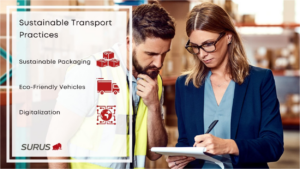As you grow your business, your carbon footprint grows too. It's inevitable. The more products you have, the more distribution mediums you need. And the more of those you have, the more fossil fuel you burn, leading to potential environmental harm. However, that doesn't have to be true. Economic growth can be green by putting sustainability at the forefront of all our business actions.
In this article, we will help small and medium-sized business owners, corporations, and non-profit organizations understand the importance of sustainable transport. More importantly, we'll elaborate on the necessity of sustainable transport, including sustainable logistics practices that aim to reduce carbon emissions.
Table of Contents
With the growing demand for consumer goods, freight distribution has become a significant source of carbon emissions. Logistics suppliers have been opting for sustainable logistics solutions to mitigate the environmental impact of freight transport.
Green logistics is a practice that promotes eco-friendly and efficient freight delivery and logistics procedures. Implementing green logistics seeks to reduce carbon emissions from transportation, packaging, and waste management.
But how do we attain green logistics? There are many, but here are two effective practices that can make an immediate difference:
In transporting a relatively small amount of goods, less-than-truckload (LTL) transport is more efficient than a full-truckload (FTL) delivery. In an FTL delivery, you pay for the exclusive use of the whole truck. However, multiple shippers can share the spaces in a single truck upon delivery of freights using LTL shipments, making it less costly. Additionally, the use of LTL helps minimize the use of empty trucks, reducing carbon emissions.
There are other modes of transport you can choose to deliver your goods other than road transport. These modes include sea and rail transport. Sea transport utilizes ships that can hold a considerable amount of goods at a cheaper cost. On the other hand, trains in rail transport are fuel-efficient in transporting freight as they can store more loads and travel longer distances.
Intermodal shipping is another sustainable option for shipments with a flexible delivery timeframe. In intermodal transport, your freight is stored in a container and transferred using two or more modes of transportation.
Intermodal transportation also allows you to take advantage of the lower delivery costs of sea and rail transportation while only using truck transportation for last-mile deliveries. Moreover, intermodal transport significantly reduces your shipment’s carbon footprint. For instance, trains emit less carbon per ton-mile than trucks with the same loads and distance traveled.
However, this method demonstrates more modes of transportation, resulting in more time to get the shipment to its final destination.
Both logistics suppliers and shippers can now use transportation software to monitor and further reduce carbon emissions of shipment deliveries. Here are some of the software that you can use:
A carbon emission calculator can readily calculate the carbon emissions of your freight as it is transported from one place to another. In a carbon emission calculator, you only need to supply the means of delivery, shipment weight, and transport route to determine the carbon emission value automatically. The software also allows you to select two or more transport modes if you have opted for intermodal transport for your freight.
Digital freight matching (DFM) software allows you to find truck carriers that can readily transport your goods using your preferred truck types. A DFM provides you with transparent delivery charges and real-time freight shipping status. DFM can help cut carbon emissions by reducing the number of empty trucks on the road and making better truck space usage.
Nowadays, delivery drivers can use route optimization software to find the most cost-effective and fuel-efficient routes for freight transport. A route optimization software can significantly improve the delivery driver’s productivity by potentially reducing the delivery time and distance while also increasing the number of transported goods.
Several transportation companies have been opting for sustainable transport practices. These practices involve an active reduction of carbon footprints associated with logistics procedures.

One way to mitigate the increase in carbon emissions is to employ sustainable packaging solutions. More companies have been using recycled materials in containing their products.
Corrugated cardboards are now being used to protect the products instead of the traditional non-recyclable Styrofoam. The use of plastic materials, including the packaging size, has also been reduced to lessen waste materials further.
Some companies have shifted to using eco-friendly vehicles for sustainable transport, such as hybrid and fully electric vehicles. These modern vehicles have better engines that effectively minimize carbon emissions.
Hybrid electric vehicles combine combustion engines and electric motors to provide better fuel economy. Fully electric vehicles are another sustainable transport alternative that demands significant investment from freight transportation companies. Though fully electric vehicles are costly, they emit no gas, thus significantly reducing their carbon footprint.
Technological advancements have been vital in raising environmental consciousness and reducing carbon footprints, notably in freight transportation. New transportation software products (carbon emission calculators, digital freight matching, and route optimization) enable you to monitor and reduce your shipments' carbon emissions.
Digitalization also allows companies to minimize paper consumption by replacing the traditional paper-based logistics materials, including proof of delivery and other shipment details, with an electronic copy.
As a product consumer or business retailer, you can help reduce carbon emissions by employing sustainable transportation practices. You can achieve this by using the most efficient mode of transport that matches your shipping needs.
At Surus, we can automate all of the above for you. We offer sustainable distribution solutions through proven-sustainable logistics and supply chain systems. With us, rest assured that your carbon footprint is always at a minimum. As Michigan's leading sustainable logistics provider with an eco-friendly fleet, we are committed to serving your distribution needs with the environment in mind. Get a free quote by contacting us right now.